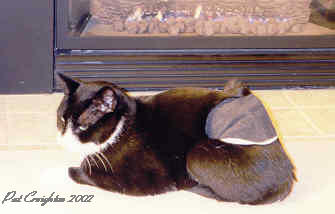Chemotherapy Protocols:
The hardest information we had to find in a short space of time is an outline for
Dr Rogers Fred III protocol, that contains Elspar, and has definitely saved his life at one point in time as the Elspar was necessary to reduce the size of a tumor cutting off Max's esophagus, so that he couldn't swallow, at all. We thank Dr Fred for his information, and for the followup support he gave to our veterinarian, as needed. So far, his support has given Max more than an extra year of life, interacting with the world he loves.
Dr Rogers Fred III Rescue Protocol:
This list doesn't give dosages, however, a knowledgable veterinarian should be able to work out what your cat needs:
Induction:
(5mg prednisolone daily)
Week 1: Elspar(L-aspiranginase) and Oncovin(vincristine) (both IV)
Week 2: Oncovin(vincristine) and Cytoxan(cyclophosphamide) (both IV)
Week 3: Oncovin(vincristine) and Cytoxan(cyclophosphamide) (both IV)
Week 4: Adriamycin(doxorubicin) (IV)
Week 5: No chemo. Do x-ray and chem profile
Repeat Entire Cycle One Time
Maintenance:
(5mg prednisolone every other day)
Treatment 1: Elspar(L-aspiranginase) and Oncovin(vincristine) (bothIV)
Treatment 2: Oncovin(vincristine) and Cytoxan(cyclophosphamide) (bothIV)
Treatment 3: Oncovin(vincristine) and Cytoxan(cyclophosphamide) (bothIV)
Treatment 4: Oncovin(vincristine) and Cytoxan(cyclophosphamide) (bothIV)
Treatment 5: Rheumatrex(methotrexate) (Oral or IV)
Do x-rays and chem profile on last week of each cycle
Repeat entire cycle two time at 2 week intervals (20 weeks total)
Repeat entire cycle five times at 3 week intervals (75 weeks total)
Red Bank Veterinary Hospital
197 Hance AvenueTinton Falls, NJ 07724
Ph:
(732) 747-3636Fx:
(732) 747-6562www.rbvh.netRecently, we have added Cytosine Arabinoside which is showing some effect. We add it as a separate protocol, with recommendations from Dr Fred regarding spacing of time between treatments.
The effects include the fact that Max is now rushing to litter boxes to eliminate feces/urine, (not sure which, yet), even though he cannot climb into the litter box at this point in time. Poor little fellow looks inside the box, and hangs his head as he is aware he can't climb into it. Sometimes this is all very hard, both to maintain, and to watch, but his adoring looks and purrs when when I give him his massages make up for it, as do his attempts to be 'normal' with the other boys, who are not treating him like a vulnerable victim, as his upper body is extremely strong.
 Max's Original Chemotherapy Protocol:
Max's Original Chemotherapy Protocol:Provided in May 2002
Induction:
Vincristine 0.5 mg/m² IV once weekly
Cyclophosphamide 50mg/m² PO q. 48 hours
Cytosine arabinoside 100mg/m² SC day 1 and day 2
Prednisone 40 mg/m² q 24 hrs for 1 week, then 20 mg/m² q 48 hrs for 6 weeks
The above phase is continued for six weeks.
Maintenance:
Methotrexate 2.5mg/m² PO 3x per week
Chlorambucil 20mg/m² PO q 2 weeks
Prednisone 20mg/m² PO q 48 hours
Vincristine 0.5mg/m² IV every 4 weeks
There was no discussed protocol for long term maintenance as Max was showing no signs of residual cancer. We dropped the prednisone quite early in the maintenance phase as we have concerns about its long term use. We did the maintenance protocol about twice, without prednisone, before deciding to stop chemo altogether. Our choice wasn't wrong in this particular situation as Max did not come out of remission for three and a half years, at which time there were new issues and a new protocol was chosen, both by us, and by our veterinarian, that was more appropriate for the battle back into remission again.
After an ultrasound showed no signs of lymphoma, along with blood tests showing him clear, we decided against maintenance the first time we used the second protocol, (Dr Fred's), however, we feel this was a bad decision as he came out of remission within about three or four months.
The fact that Cytosine arabinoside MAY have had a benefit for Max in the early days of his cancer is worthy of note, as his cancer stayed away for so long, and since returning, (without the Cytosine arabinoside), it has hit his spine twice; once with a lump attached to the spine, and second with presence in the spinal fluids, causing him to have lower paralysis, including effecting his ellimination processes. The Cytosine arabinoside is again having some effect as we eventually added it as a separate protocol, with recommendations from Dr Fred regarding spacing of time between treatments. This, of course, is personal observation, not scientific proof that the drug caused the improvement.

Prednisone Concerns:
The second round of Dr. Fred's protocol was about half way through the first maintenance round when Max developed limb weakness, and regressed quite quickly into some paralysis. We attempted to use specialists at Canada West in the hopes that they could come up with better ideas and answers. I was hoping that the choice would be made to use Cytosine arabinoside as I had read a lot about its success. This was started, but then, just as some slight improvement was starting to show, Canada West switched to Lomustine without consulting us. They had a legal right to do this as we had signed waivers, based upon the fact that they had chosen the preferred drug in the beginning.
Canada West also insisted we needed to double Max's dose of prednisone, and, against my better judgement, I accepted their choice and administered it for a short period, until I saw just how much muscle wasting was happening as a result.
The following sites clarify why I do not like using prednisone, which is good for short term prevention of inflamation, but has its side effects:
For patients on oral corticosteroids, another serious potential side effect is suppression of the hypothalamic-pituitary-adrenal (HPA) axis, which can lead to adrenal insufficiency, said Serge A. Jabbour, M.D., of the Thomas Jefferson University here.
and at the same site:
The portion of the inhaled drug that does not make it into the lung but is instead swallowed, and the ensuing systemic effect interferes with the growth process.
Evidence that prednisone-induced myopathy is reversed by physical training.
Human growth hormone prevents the protein catabolic side effects of prednisone in humans.
The ratio of observed to predicted (by nomogram) urinary creatinine excretion was lower in patients than controls, resulting in a corresponding underprediction of creatinine clearance by nomograms in the patients taking prednisone
Effect of Short-Term Prednisone Use on Blood Flow, Muscle Protein Metabolism, and Function
SIDE EFFECTS: Fluid and Electrolyte Disturbances, Musculoskeletal, Gastrointestinal, Sermatologic, Metabolic.

Physiotherapy:
When I consulted a physiotherapist about what could be done to help Max recover use of limbs that had wasted so badly in a short period of time, she suggested using the full range of movement for each leg.
- I started by stretching the leg to its full extent, gently pushing it back close to his torso, and then stretching it up to his head, and back again. The first day I started with five on each leg, then next day I did ten, and so I have increased it to the point where we are now doing three batches of 50 per leg, to make 150 per day. There were days that he was showing less appreciation than normal where I would cut back a bit, or not increase the number of stretchs.
- The second stage of this is rubbing toes, and limbs to increase circulation as flow of blood is important for maintenance of the limb. I do this by rubbing them gently between my hands.
- The third thing I do is massage the spine, gently, as another method of getting blood to flow to areas affecting, or affected by the paralyis.
- The forth area that I personally have spent less time on is Max's tail. I should probably work harder on his tail as I can see his old 'annoyance' flick once in a while when I am massaging legs. This may, or may not, be related to improvement.

Aside from chemo drugs, we have been consistantly giving Max a #4 size capsule of Moducare, twice a day, Vitamin E, (200IU D-Alpha Tocopheryl), twice a week, and recently added ascorbic acid in #3 gelatine capsules. As Max's kidneys were enlarged from the start, in 2002, we are also including a ground tablet of Renal Essentials in a #3 capsule. Our personal observations are that this may be providing some support as his kidneys have reduced in size in the latest ultrasounds done this year, which was why we mistakenly stopped chemo with such confidence. At the present time we have also added Maglucate as a gentle feline form of Phillips Milk of Magnesia, mainly because it contains magnesium gluconate. So far we are not observing improvement with the Maglucate as he has lost peristalsis, but the stools are softer.
Poor little guy is starting to feel like a medicine cabinet before meals.
 At left Max is just 'hanging out' as the sun has gone down and there is no activity out his favorite window. He is on a bench we built for him, to keep him mentally fit with the stimulation of outdoors.........you know, squirrels, birds, especially crows, can get even a paralyzed boy on all fours.
At left Max is just 'hanging out' as the sun has gone down and there is no activity out his favorite window. He is on a bench we built for him, to keep him mentally fit with the stimulation of outdoors.........you know, squirrels, birds, especially crows, can get even a paralyzed boy on all fours.











 It is extremely hard for any pet owner to switch from primary caregiver to being the person that chooses the release from pain for an animal in distress. While I have trained in courses that include
It is extremely hard for any pet owner to switch from primary caregiver to being the person that chooses the release from pain for an animal in distress. While I have trained in courses that include 